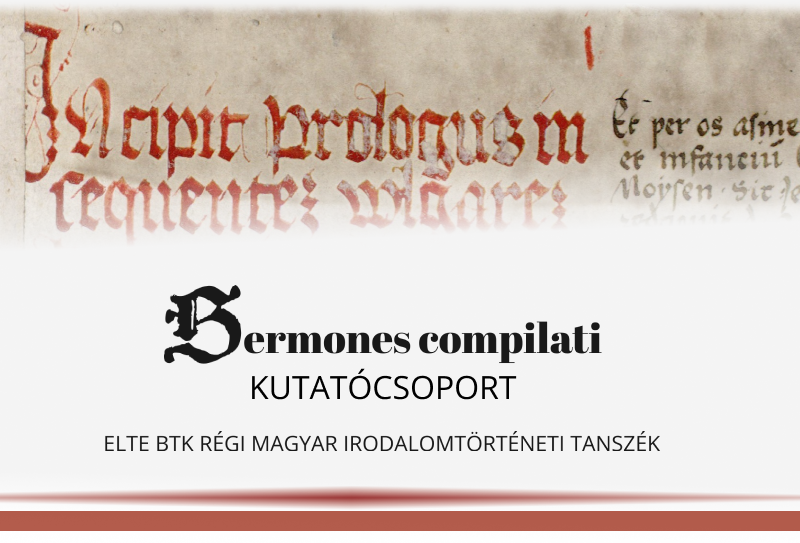Untitled Document
PLAUSTRUM II
Full studies in Hungarian can be found here
Resumes
Borbála LOVAS:
Adam under the Cross
An Analysis of the History of Symbols Based on the Holy Cross Legend from the Érdy Codex
The essay examines the iconography of Adam under the Holy Cross and how the image of the Cross has come to represent the connection between the Old and New Testaments as the Cross, the symbol of salvation and the tree of knowledge, the symbol of original sin have become related to each other. The purpose of the study is to follow the image through apocryphal gospels (e.g. The Gospel of Nicodemi, Vita Adae et Evae), collections of legends, (Legenda Aurea, Catalogus Sanctorum), old codices and works of visual arts.
Ilona KERTÉSZ:
Two Versions of the Legend of St. Urban from the Érdy Codex and their Connection with the Text of the Legenda Aurea
While preparing the online digital edition of the Érdy Codex, the Karthauzi Névtelen’s translation and composition techniques were examined. The legend of St. Urban appears twice possibly because of a change in his structural concept. A comparison of the two translations shows that the second appears to be translated not from a Latin source but is a remade version of the earlier Hungarian translation.
Zsófia ALBRECHT:
Rome and the Érdy Codex
We tend to assume that one of the ways the prominent artists of our past acquired knowledge was through their travels abroad. We assume that the Karthauzi Névtelen (the unnamed author of the Érdy Codex), the author of the most important Hungarian collection of sermons and legends from the Middle Ages travelled to Rome because of his precise accounts of physical locations in his works. By examining our Latin sources however, we find out most of the information came from preaching manuals, pilgrimage itineraries. Even his knowledge of familiar Hungarian places was possibly replaced by information from these sources.
Dóra BAKONYI – Brigitta LUDÁNYI:
Hyphenation Habits – a Comparative Analysis of the Assumed Two Scribes of The Érdy Codex and the Script of the Jordánszky Codex
There are several existing opinions as to whether the Érdy Codex was written by a single or two separate scribes. The purpose of this study is to look further into this question. The study uses both the Érdy Codex and the extremely similar Jordanszky Codex. One basic assumption for the study is that the use of hyphens in the original text does not influence the way hyphenated words or phrases are written in the copied versions. With this, the hyphenation habits and patterns can be regarded as evidence for distinguishing between the two scribes.
The conclusions are based on 2500 words taken from 63 pages of the 675-page Érdy Codex and 300 words taken from 16 pages of the 400-page Jordánszky Codex. The results show that the supposed three scribes had similar hyphenation habits. The lack of significant difference supports the assumption that the Érdy Codex was written by one scribe.
Nóra SÁPI:
“Senarius Dicitur Numerus Perfectus”
To the Arithmetic of Pelbárt
Numbers play an important role in the sermons of Pelbartus de Themeswar. Sermons in his era were divided into their sections according to specific numbers, which took into account numerology and other speculations about the significance of numbers. This study examines Pelbartus’ use of these numbers and draws a parallel between the work of Pelbartus and that of Fransiscus de Mayronis who, 200 years earlier used similar systems of numbers.
Flóra RAJHONA:
On the Latin Sources of Péter Pázmány’s Sermons
In researching the sermons of Péter Pázmány it is very important to investigate the sources he used. Our group has been researching the structural and compositional principles of the sermons. Foremost, we are analyzing groups of motifs that might help with the identification of sources. Our main aim is to emphasize the connection between the Baroque and Medieval tradition of sermon writing. Our research focuses on the role of exemplum and sententia and placement of Latin quotations and their importance within the speech.
Boglárka NANYISTA:
„From Everyday Experience to Secret Teachings” the Variations of Scientific Thinking in the Sermons of Péter Pázmány
There is a well distinguished group of examples in Baroque sermons that are linked to the results or methods of scientific thinking. Because the moral lesson was a priority the preachers did not consider it their task to share up-to-date knowledge but instead used knowledge relating to everyday experience or knowledge already strengthened by oral tradition to prove their points. Knowledge connected to different professions, ranks, medicine, and astronomical images are common. It also occurs that the same image is used in different interpretations. For example there are many different uses refering to Lucretius’ observation of particles of dust.
Balázs KERTÉSZ:
Osvát Laskai on the Hungarians’ Arrival to Pannonia
Osvaldus de Lasko, in his work „Sermones de sanctis Biga salutis intitunlati,” used not only legends but also chronicles for the sermons he wrote for the feast of the saints of the Árpád dynasty. His mistakes show that he is often quoting from memory. In one of his speeches for the feast of St. Stephen while speaking of the first and second arrival of Hungarian tribes he recalls the birth of Álmos and the tale of the „Turul”. To this he adds the additional motif of a family tree growing from the mother’s womb on which the holy Hungarian kings appear: Stephanus, Emericus and Ladislaus from the Árpád dynasty and Ludovicus from the Anjou dynasty.


